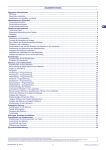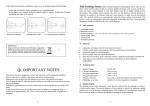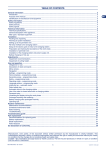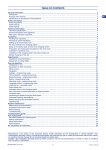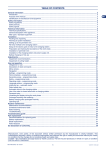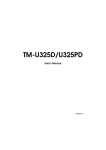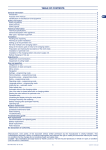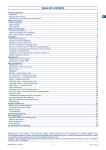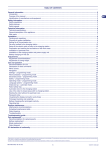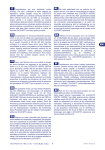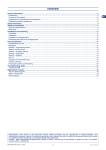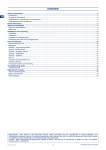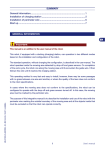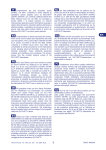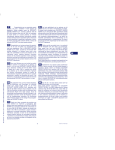Download User`s manual TABLE OF CONTENTS General
Transcript
TABLE OF CONTENTS
General information. ................................................................................................................................................................... 2
Introduction. ................................................................................................................................................................................ 2
Purpose of the manual. ............................................................................................................................................................... 2
Identification of manufacturer and equipment. ............................................................................................................................ 2
Safety information. ...................................................................................................................................................................... 3
Safety regulations. ...................................................................................................................................................................... 3
Safety devices. ............................................................................................................................................................................ 4
Safety signals. ............................................................................................................................................................................. 4
Technical information. ................................................................................................................................................................ 5
Technical specifications............................................................................................................................................................... 5
General description of the appliance........................................................................................................................................... 6
Main parts. .................................................................................................................................................................................. 7
Installation.................................................................................................................................................................................... 8
Packing and unpacking. .............................................................................................................................................................. 8
Planning of system installation. ................................................................................................................................................... 8
Setting up of the perimeter wire. ................................................................................................................................................. 9
Re-entry method to the charging station. .................................................................................................................................. 10
Setup of the robot’s quick re-entry to the charging station. ....................................................................................................... 10
Preparation and marking the boundaries of the work areas. .....................................................................................................11
Installation of perimeter wire. .................................................................................................................................................... 14
Installation of the charging station and power supply unit......................................................................................................... 16
Battery charging on first use. .................................................................................................................................................... 17
Adjustments. .............................................................................................................................................................................. 17
Adjustment recommendations................................................................................................................................................... 17
Adjustment of cutting height. ..................................................................................................................................................... 17
Use and operation. .................................................................................................................................................................... 18
Recommendations for use. ....................................................................................................................................................... 18
Description of robot commands. ............................................................................................................................................... 18
Menu access. ............................................................................................................................................................................ 18
Navigation. ................................................................................................................................................................................ 18
Settings – programming mode. ................................................................................................................................................. 20
Work schedules – programming mode. .................................................................................................................................... 21
Secondary areas – programming mode. ................................................................................................................................... 22
Safety – programming mode. .................................................................................................................................................... 22
Operating mode – programming mode. .................................................................................................................................... 23
Language options – programming mode. ................................................................................................................................. 23
Initial start up – automatic mode. .............................................................................................................................................. 23
Robot safety stop. ..................................................................................................................................................................... 24
Automatic return to the charging station. .................................................................................................................................. 24
Use of the robot in closed areas with no charging station......................................................................................................... 24
Starting the robot without the perimeter wire. ........................................................................................................................... 25
Password entry.......................................................................................................................................................................... 25
Visualising the display during the work phase. ......................................................................................................................... 26
Prolonged inactivity and restarting. ........................................................................................................................................... 26
Battery charging after prolonged inactivity. ............................................................................................................................... 27
Operating tips. ........................................................................................................................................................................... 27
Routine maintenance. ............................................................................................................................................................... 28
Maintenance recommandations. ............................................................................................................................................... 28
Scheduled maintenance table. .................................................................................................................................................. 28
Robot cleaning. ......................................................................................................................................................................... 28
Troubleshooting. ....................................................................................................................................................................... 29
Troubleshooting guide. ............................................................................................................................................................. 29
Part replacement. ...................................................................................................................................................................... 31
Recommendations for replacing parts. ..................................................................................................................................... 31
Battery replacement. ................................................................................................................................................................. 31
Blade replacement. ................................................................................................................................................................... 32
Robot disposal. ......................................................................................................................................................................... 32
Declaration of conformity. ........................................................................................................................................................ 32
Reproduction, even partial, of this document without written permission by the manufacturer is strictly forbidden. The manufacturer assumes a policy of continual improvement and reserves the right to modify this document without
prior notice on condition that the changes do not constitute health and safety risks.
© 2008 – Text, illustrations and page layout by Tipolito La Zecca. The text may be reproduced, in whole or in part, on condition that the author is mentioned.
MD-CT-RO-05-R2.0 - EN - 11-2012
1
User’s manual
EN
GENERAL INFORMATION
INTRODUCTION
EN
Congratulations on purchasing this product, which we are certain will meet your needs and expectations. This project was created by ZUCCHETTI
CENTRO SISTEMI S.p.A. (UNI EN ISO 9001 certified company), a software house that since 1982 has consolidated its activities and presence
on the international market.
Applying advanced IT solutions in the field of industrial automation means optimising the production activities and simplifying the work procedures.
This product was created on the basis of on-going research by ZUCCHETTI’s laboratories.
PURPOSE OF THE MANUAL
•
This manual forms an integral part of the appliance and was produced by the Manufacturer to provide the necessary information to people
authorised to interact with it during its working life.
•
Operators of the appliance must adopt correct working practices and must carefully read and follow all the instructions contained in this
manual.
•
This manual is written by the Manufacturer in the original language of Italian and may be translated into other languages to meet legal and/
or commercial requirements.
•
Carefully read the instructions contained in this manual to avoid any unnecessary risks to people’s health and safety, as well as economic
damages.
•
Keep this manual in a safe and easily accessible place for quick reference.
•
Some information and illustrations contained in this manual may not perfectly correspond with the appliance in your possession; however,
this does not affect its functioning.
•
The Manufacturer reserves the right to make changes without any obligation to provide prior notice.
•
The following symbols are used throughout this manual to highlight some particularly important information or to identify some important
specifications.
Danger - Attention
This symbol indicates situations involving imminent danger, which, if ignored, could put people’s health and safety at risk.
Warning – Caution
This symbol indicates situations where it is necessary to behave in a certain way in order to avoid putting people’s health
and safety at risk, and to protect the device.
Important
This symbol identifies particularly important technical information which must not be ignored.
IDENTIFICATION OF MANUFACTURER AND EQUIPMENT
The nameplate shown here is applied directly onto the appliance. It
contains references and all the information essential for safely operating
the device.
For any technical requirements, please contact the Manufacturer’s
Technical Service Centre or an authorised dealer.
For technical assistance, please indicate the data reported on the
identification plate, the approximate hours of use and the type of fault
detected.
DATA PLATE
(A) Name of manufacturer
(B) CE conformity label
A. Name of manufacturer
(C) Model
B. CE conformity label
(D) Technical specifications
C. Model / serial number / manufacturing year
(C) Serial number
D. Technical specifications
User’s manual
2
(C) Manufacturing year
SAFETY INFORMATION
SAFETY REGULATIONS
•
During design and construction, the manufacturer carefully considered the possible hazards and personal risks that may result from
interacting with the equipment. In addition to observing the applicable laws in force, the manufacturer adopted all the “good manufacturing
practice regulations.” The purpose of this information is to inform users on the need to use extreme caution to avoid risks.
•
When using the robot for the first time, it is recommended to carefully read the whole manual and to be sure to fully understand it, especially
the safety information.
•
Lift and handle the equipment according to the information reported on the packaging, on the appliance and in the user instructions supplied
by the Manufacturer.
•
Pay attention to the symbols that appear on all the safety labels. They are coded by shape and colour for safety purposes. Keep them legible
and always follow the instructions indicated.
•
The lawn mower robot can only be used by people who know how to operate it and who have read and understood the instructions in this
manual.
•
Only use the equipment for the purposes specifically intended by the manufacturer. Improper use of the equipment may be hazardous to
personal safety and health and may lead to economic losses.
•
Before using the lawn mower robot , make sure there are no objects on the lawn (toys, tree branches, clothing items, etc.).
•
When using the robot, make sure there are no people (especially children, the elderly or disabled people) and pets in the work area so as to
prevent safety risks. To avoid this risk, it is recommended to program the robot to operate at suitable times of the day.
•
Never allow people to sit on the robot.
•
Never lift the robot to inspect the blade while it is running.
•
Do not place hands and feet under the robot when it is in operation and moving, especially near the wheel area.
•
Never remove, bypass or tamper with the safety devices installed. The failure to observe these requirements may lead to serious personal
health and safety risks.
•
Perform all maintenance activities recommended by the manufacturer. Proper maintenance will allow obtaining the best performances and
longer operating times.
•
Before maintenance or adjustments, which can also be performed by a user with minimal technical competence, disconnect the power
supply. The user must ensure that all the necessary safety conditions are in place, especially when working on the lower part of the lawn
mower robot, following the Manufacturer’s procedures and instructions.
•
Use the personal protection devices recommended by the Manufacturer, in particular, always wear protective gloves when handling the
cutting blade.
•
Before replacing the batteries, always remove the blade.
•
Make sure the air vents of the power supply unit are free and clear of residuals.
•
To avoid irreversible damage to the electric and electronic parts, do not wash the robot with water jets at a high pressure and do not immerse
it in water, partially or completely, as it is not watertight.
•
Operators who perform repairs during the working life of the robot must have the necessary technical expertise, skills and experience in this
specific field. The lack of these requirements may be hazardous to the health and safety of people.
•
Any work to be performed on the charging station must be carried out with plug of the power cord disconnected.
•
Replace any worn or deteriorated parts with original spare parts to ensure proper functioning and safety.
•
The robot cannot be used without the top cover. If the mechanical parts of the robot are damaged, replace them.
•
Any routine or extraordinary maintenance (e.g. battery replacement) must be performed by an authorised service centre.
•
The Manufacturer shall not be held liable if non-original spare parts are used.
•
Never use and recharge the robot in explosive and/or flammable environments.
3
User’s manual
EN
SAFETY DEVICES
1. Bumpers
EN
The bumper sensor is activated if the robot strikes a solid object greater than 10 cm (3.94 ") in height, which stops the movement in that direction
and moves backwards to avoid the obstacle.
2. Inclinometer
If the robot works on a slope which is steeper than the maximum limit, or tips over, the robot will stop the cutting blade.
3. Emergency stop switch
Located on the control panel with the word STOP larger than the other commands on the keypad. Pressing this button at any time during
operation will immediately stop the movement of the lawnmower robot and the rotation of the blade will stop within 2 seconds.
4. Over-current protection
Each motor (blade and wheels) is monitored continuously during operation for any situation that may cause them to overheat. If this occurs
in the wheel motor, the robot will attempt to move in the opposite direction. If the over-current persists, the robot will stop and signal an error.
If the cutting blade motor overheats, there are two intervention ranges. If the parameters fall within the first range, the robot will perform the
manoeuvres to unblock the cutting blade. If the over-current is below the protection range, the robot will stop and signal a motor error.
5. No sensor signal
If there is no signal on the perimeter cable, the robot will automatically stop.
6. Lifting sensor
If the robot is lifted from the ground by the central handle, the cutting blade will stop rotating.
SAFETY SIGNALS
This
product
is
password
protected. Keep the code in a safe
place.
Attention! Do not clean or wash
the robot with water.
Carefully
read
the
user
instructions and ensure that you
fully understand them before
using the robot.
Keep children, pets and other
people a safe distance away when
the robot is in operation.
Carefully follow the warning
and safety recommendations
contained in this manual to
guarantee
the
safety
and
efficiency of the robot.
This product complies with the
current CE directives.
Keep hands and feet away from
the cutting blade. Never place
your hands or feet under the body
or close to the robot when it is in
operation.
User’s manual
4
TECHNICAL INFORMATION
TECHNICAL SPECIFICATIONS
EN
Model
Description
2L2DE0
2L2EV0
2L2EL0 - 2L2LL
3500 ( 37660 )
Maximum recommended surface that can be mowed
Robot equipped with one lithium battery
m2 (sq ')
2600 ( 27976 )
Robot equipped with two lithium batteries
m2 (sq ')
3000 ( 32280 )
mm (")
614x281x484 ( 24,17 x 11,06 x 19,05 ” )
Characteristics
Size (W x H x D)
Robot weight (incl. battery)
kg
13,5
14,5
Cutting height (Min-Max)
mm (")
20-45 ( 0,79-1,77 ")
Diameter of blade with 4 cutting edges
mm (")
290 ( 11,42 “)
Electric motors
Cutting blade speed
Ground speed
V
RPM
4000 Cut
Metres / Minute
Maximum slope Recommended
%
Ambient operating temperature
Max°
ca. (25.2 V) without
brushes
ca. (25.2V) with brushes
3000 Maintenance
30 (98.43 ')
45%. Allowable, based on the lawn conditions and accessories installed.
35%. Maximum. In regular lawn conditions.
20%. In proximity of the outside edge or perimeter wire.
ROBOT -10°(14 F.) (Min) +50° (122 F.) (Max)
BATTERY CHARGER -10°(14 F.) (Min) +40° (104 F.) (Max)
Measured noise level
dB(A)
75 (Max) − 65 (Lawn maintenance)
Water protection class
IP
IP21
Electrical features
Power Supply unit (for lithium battery)
Class 1(Vin 90 - 295Vac 47/63Hz ) AC current (typ.) 2A/115Vac 1 A/230Vac
Type of accumulator and charging batteries
Rechargeable Lithium-Ion Battery
V-A
Battery charger
V-A
Average recharging time and method
Average operating time (*)
25.2V –1x6.9Ah
25.2V – 2x6.9Ah
29.3 Vcc - 5.0 Ah
3:00 - automatic
4:00 - automatic
4:30 - automatic
3:00
4:30
6:00
Hours
Blade safety stop
Rollover sensor
standard
Handle sensor
standard
Emergency button
standard
Equipment and accessories
Perimeter wire
m (')
150 ( 492 ' )
Maximum length of perimeter wire (indicative,
calculated based on a regular perimeter)
m (')
600 (1000 with upgraded transmitter, not supplied) ( 1968 – 3280 ' )
5
User’s manual
Fastening nails
n°
200
Areas managed, including the primary one
EN
4
Sinusoid perimeter signal (patented)
standard
Rain sensor
standard
Blade modulation and intelligent spiral
standard
Mowed lawn sensor - Auto Setup (patented)
Not Available
Acoustic alarm
standard
Optional
Remote control/Console
standard
Optional
Necessary in case of long perimeter wire or in the presence of a disturbed or weak
signal
Upgraded perimeter wire transmitter
Optional
External box for holding the battery charger and the signal transmitter
Power supply safety box
Optional
Useful for recharging the batteries in winter or after prolonged inactivity
Battery recharging kit
Optional
(*) Depending on the condition of the grass and lawn surface
GENERAL DESCRIPTION OF THE APPLIANCE
The appliance is a robot designed and built to automatically trim grass
in gardens and house lawns at any time of the day or night. It is small,
compact, silent and easy to transport.
Depending on the characteristics of the surface to be trimmed, the robot
can be programmed to work on more than one area: a primary area and
secondary areas (according to the specifications of the various models).
During operation, the robot trims the area marked off by the perimeter wire.
When the robot detects the perimeter wire or encounters an obstacle, it
changes direction in a random manner and starts mowing again in a new
direction.
According to its operating principle random, the robot automatically trims
the entire delimited area of the lawn (see figure).
The robot is able to recognise the presence of higher and/or thicker grass
in an area of the garden and to automatically activate, if considered
necessary, the spiral movement for a perfect finish. The spiral movement
can also be activated by pressing ENTER/MENU while the robot is mowing.
The lawn surface that the robot is able to trim depends on a series of
factors, such as:
•
model of the robot and type of batteries installed
•
characteristics of the area (irregular perimeters, uneven surfaces,
divided areas, etc.)
•
characteristics of the lawn (type and height of the grass, moisture, etc.)
•
conditions of the blade (level of sharpness, without residuals and
deposits, etc.)
User’s manual
6
RANDOM OPERATION
MAIN PARTS
1. Robot.
2. Keyboard commands: for setting and displaying the operating modes of the robot.
EN
3. Rain sensor: detects rain and commands the robot to return to the charging station.
4. Battery: supplies power to the motors of the blade and drives the wheels. The robot is supplied with one or more lithium batteries located
under the models already assembled in some models.
5. Handle: for lifting and carrying the robot.
6. Cutting blade : cuts the grass already assembled in some models.
7. Perimeter wire coil: cable with special insulation and special features for carrying the signal needed to operate the robot.
8. Pegs : for securing the perimeter wire and the charging station.
9. Power cord for the power supply unit.
10. Power Supply unit : supplies power in low voltage to the batteries.
11. Charging station: for recharging or keeping the robot charged.
12. Transmitter: transmits the signal to the perimeter wire.
13. User manual.
2
7
1
3
10
12
8
4
13
11
5
9
6
7
User’s manual
INSTALLATION
PACKING AND UNPACKING
EN
The equipment is delivered suitably packaged. When unpacking, carefully remove and check the integrity of the parts.
Important
•
Keep the packaging materials for future use.
PLANNING OF SYSTEM INSTALLATION
The robot is not difficult to install, but requires some preliminary planning in order to find the best area for installing the charging station, power
supply unit and for laying out the perimeter wire.
•
The charging station must be positioned on the edge of the lawn,
preferably in the largest area from which other areas of the lawn are
easily accessible. The area where the charging station is installed is
hereinafter referred to as the “Primary Area.”
Power supply unit
transmitter
Warning – Caution
Position the power supply unit in an area that cannot be
reached by children. For example, at a height above 160
cm (63 ").
Min. height. 160 cm
/ 63 "
perimeter wire
charging station
Warning – Caution
When connecting the electricity, it is necessary that a power outlet is positioned near the installation area. Make sure the
connection to the mains power complies with the applicable laws. To operate in complete safety, make sure the electrical
system, which is connected to the power supply unit, is equipped with a well-functioning earthing system.
Important
It is advisable to install the unit in a cabinet for electric components (for outdoor or indoor use), equipped with a key lock,
and well-ventilated to maintain a correct air circulation.
Warning – Caution
Make sure only authorised people have access to the power supply.
•
The robot must be able to easily find the charging station at the end of the work cycle, which will also be the starting point for a new work
cycle and for reaching any other work areas, hereinafter referred to as “Secondary Areas.”
•
Position the charging station according to these rules:
-
On level ground
On compact and stable ground with good drainage
Preferably in the area of the longer lawn.
In case of sprinklers, make sure the water jets are not directed inside the charging station.
Make sure the entrance of the charging station is positioned as shown in the figure, so that the robot can enter it by following the perimeter
wire in a clockwise direction.
There must be a straight area of 400 cm (157.48 ") in front of the base.
•
The charging station must be well fastened to the ground. To prevent a small step from forming at the front of the base, position a small
piece of fake grass at its entrance to stop this from occurring. Alternatively, remove part of the grassy surface and install the base flush with
the grass.
•
The charging station is connected to the power supply unit via a cord that must move away from the charging station on the outside of the
cutting area.
User’s manual
8
•
•
Position the power supply unit according to these rules:
OK
OK
If positioned outdoors, the robot must not be exposed to direct
sunlight and water. Therefore, it must be protected inside a
ventilated box. Do not position in direct contact with the soil or
humid environments.
NO
NO
-
Position it on the outside of the lawn and not inside.
NO
NO
-
Stretch out the excess cord going from the charging station to the
power supply unit. Do not shorten or lengthen the cord.
-
In a well-ventilated area protected against atmospheric agents and
direct sunlight.
-
Preferably inside your home, a garage or shed.
-
The incoming section of the wire must be straight and aligned
perpendicularly to the charging station by at least 200 cm (78.74 ")
and the outgoing section must move away from the charging station as
shown in the figure; this allows the correct re-entry of the robot.
power supply unit
charging station
min height 160 cm
/ 63 "
perimeter wire
transmitter
min. distance
200 cm
/ 78,74 "
If the robot is installed near an area which has another robot (from the
same or another manufacturer), then the transmitter and receiver of the
robot must be modified during installation so that the frequencies of the two
robots do not interfere with other.
SETTING UP OF THE PERIMETER WIRE
Before installing the perimeter wire, it is necessary to check the entire
surface of the lawn. Make any necessary adjustments to the grassy
surface during the laying of the perimeter wire in order to allow the robot
to function correctly.
track for laying the perimeter wire
1. Evaluate the best method for returning to the charging station according
to the instructions described in the chapter “RE-ENTRY METHOD TO
THE CHARGING STATION”.
24 v
2. Evaluate whether a special installation of the perimeter wire is
necessary according to the instructions described in the chapter
“SET-UP OF THE ROBOT’S QUICK RE-ENTRY TO THE CHARGING
STATION”.
3. Preparation and defining of the work areas.
4. Installation of the perimeter wire.
5. Installation of the charging station and power supply unit. When laying
the perimeter wire, respect the installation direction (clockwise) and
the rotation direction around the flowerbeds (counter-clockwise), As
shown in the figure.
9
User’s manual
EN
RE-ENTRY METHOD TO THE CHARGING STATION
EN
The robot can return to the charging station in two different ways based on
what is set in the user menu under the field “Settings – Re-entry to Base.”
Use the “On the Wire” method only when there are numerous obstacles
inside the garden and near the perimeter wire (within 2 meters). In all other
cases it is better to use the “Bounce on wire” method for the quickest reentry to the charging station.
“Follow wire”. This method of re-entry to the charging station commands
the robot to follow the perimeter wire, positioning its wheels on either side
of the wire. If this method is activated, there is no need to prepare the
“Recall on Wire” as described below.
5 cm.
“Bounce on wire”. By setting this method of return to the recharging
station, the robot runs alongside the perimeter wire at an indicative
distance going from a few cm to 1 m (3.2 '), touching it occasionally, until
it recognises the “Recall on the wire" needed to direct the robot into the
recharging station correctly or to guide it along narrow stretches. Once
the “Recall On the Wire” has been recognised, the robot will follow the
perimeter wire, positioning its wheels on either side of the wire for a
distance of around 10 meters. (33 ').
2 mt.
4-10 mt.
2 mt.
Passage less
than 2 meters
4-10 mt.
The “Recall on the wire” not only indicates to the robot that it is near the charging station, but also of a narrow passage or of an arrow for quick
re-entry to the charging station.
As soon as a “Recall” is recognised, the robot will follow the perimeter wire at low speed, and with more precision for around 10 meters (33 '). It
will then return to the “Bounce on wire” re-entry mode if it does not encounter the charging station or the arrow for quick re-entry.
Follow these instructions to install the “Recall.”
•
The “Recall” is a piece of wire that extends for around 2 m (6.6 ') with a distance of 5 cm (1.96 ") between each wire.
•
The “Recall” must be positioned at a distance of 4 and 10 m. (13.2 - 33 ') in front of the charging the station.
•
The “Recall” must be positioned at a distance of 2 m. (6.6 ') in front of any narrow passages.
•
The “Recall” must be positioned in the section in front of the “Quick Re-entry.”
NB: If the robot does not find the charging station within a certain amount of time, it will follow the perimeter wire in “Follow wire”
mode.
SETUP OF THE ROBOT’S QUICK RE-ENTRY TO THE CHARGING STATION
Quick re-entry requires a special installation of the perimeter wire that allows the robot to reduce the re-entry path to the charging station. This
special installation of the perimeter wire should only be used for gardens where quick re-entry significantly reduces the path and where the
perimeter length is greater than 200 meters.
To setup the quick re-entry, position the perimeter wire on the ground so that it forms a triangle with one side of 50 cm (19.7 ") and the other two
sides of 40 cm (15.75 ") each, as shown in the figure.
As the robot heads back to the charging station with the two wheels on either side of the wire, it intercepts this triangle and stops moving. It
then turns approximately 90° towards the inside of the garden and starts moving in the new direction until running into the perimeter wire on the
opposite side.
Arrange the wire for quick re-entry in a point where there is at least 200 cm (78.74 ") of straight wire in front of the station, and at least 150 cm
(59.05 ") of straight wire behind it.
Do not set up the wire along the straight section immediately in front of the charging station or near any obstacles. Make sure there are no
obstacles along the re-entry path that may obstruct the quick re-entry.
Important
An incorrect setup of the robot’s quick re-entry may prevent the robot from returning to the charging station quickly. When
the robot travels along the perimeter to reach a secondary area, it may not detect the quick re-entry setup.
User’s manual
10
The illustration provides some useful tips on how to correctly setup the
robot for a quick re-entry.
EN
50
40
4-10 mt.
40
min. 150 cm.
(59,05 ")
5 cm.
2 mt.
4-10 mt.
2 mt.
Passage less
than 2 meters
4-10 mt.
PREPARATION AND MARKING THE BOUNDARIES OF THE WORK AREAS
Preparation of the lawn to be mowed
1. Make sure the lawn to be mowed is even and does not contain holes,
NO
stones or other obstacles. If necessary, prepare the lawn by filling
in any holes and removing any obstacles. If some obstacles cannot
be removed, it is necessary to properly mark these areas with the
perimeter wire.
2. Check that no areas of the lawn exceed the allowable slopes (see
“Technical Specifications”). When working on slopes, the wheels
may slip when the robot detects the wire, causing it to fall outside the
perimeter.
Important
Areas with slopes greater than those allowed cannot be
mowed with the robot. Therefore, position the perimeter
wire in front of the slope so that it is excluded from the
area to mow.
0-20%
21-35%
OK
0-20%
OK
21-35%
NO
OK
OK
perimeter wire
perimeter wire
35 %
100 cm (39,3 ")
NO
35 cm
(13,78 ")
35 cm
(13,78 ")
0-20%
11
0-20%
User’s manual
Marking the boundary of the work area
3. Check the entire lawn surface and assess whether it is necessary
EN
to divide it into separate work areas as per the rules described here
below. Before installing the perimeter wire, check the entire path to
make this procedure easier. The illustration shows a lawn with the
track for installation of the perimeter wire.
During installation, identify any secondary areas and closed areas. A
secondary area is part of a lawn connected to the primary lawn with
a passage that is difficult to reach by the robot's normal movement.
The area must be reachable without any rises or drops greater than
those allowed. Whether a zone is to be defined a “secondary area”
also depends on the size of the primary area. The larger the primary
area, the harder it will be to reach narrow passages. More generally,
a passage narrower than 200 cm (78.74 ") is considered a secondary
area. The number of secondary areas managed depends on the
characteristics of the model (See “Technical Specifications”).
Track for laying the perimeter wire
min. 70 cm / 27,56 "
min. 70 cm / 27,56 "
24 v
The minimum passage allowed is 70 cm (27.56 ") from each edge of
the perimeter wire. The perimeter wire must be positioned at a distance
of (to be indicated below) from any objects outside the lawn; therefore,
the total passage available should be 140 cm (55.12 ").
If this passage is very long, the width should not be greater than 70 cm
(27.56 ").
During programming, it is necessary to configure the size of the
secondary areas as a percentage of the lawn, and the quickest
direction for reaching it (clockwise or counter-clockwise), as well as
the number of meters of wire needed to reach the secondary area. See
“Programming Mode.”
If the aforesaid minimum requirements are not met i.e. an area
separated by a rise or drop with characteristics that cannot be
managed by the robot or a passage (corridor) narrower than 70 cm
(27.56 ") from perimeter edge to perimeter edge, then this area of the
lawn is considered a “Closed Area.” To mark a “Closed Area” lay the
outgoing and incoming perimeter wire in the same track at a maximum
distance of 1 cm (0.40 "). In this case, the robot is unable to reach the
area autonomously, and must be managed as described in the chapter
“Management of Closed Areas.” The management of “Closed Areas”
reduces the square meters that can be managed autonomously by
the robot.
PRIMARY AREA
corridor with a minimum passage
of 70 cm / 27,56 " from edge to edge.
SECONDARY AREA
PRIMARY AREA
corridor with a passage
< 70 cm / 27,56 "
CLOSED AREA
User’s manual
12
4. If there is a pavement or driveway inside or outside the work area, which is at the same level of the lawn, lay the perimeter wire at a distance
of 5 cm (1.96 ") from the edge of the pavement. The robot will come out slightly from the lawn and all the grass will be mowed. If the pavement
is made of metal or if there is a metal manhole cover, shower plate or electrical wires, lay the perimeter wire at least 30 cm (11.81 ") from the
metal object in order to prevent malfunction of the robot and disturbances on the perimeter wire.
EN
Important
The illustration shows an example of the elements inside and on the perimeter of the work area and the distances to follow
for the correct laying of the perimeter wire. Mark the boundary of elements in iron or other metals (drain covers, electric
connections, etc.) to prevent any interferences to the signal of the perimeter wire.
30 cm
5 cm
11,81 “
1,97 “
30 cm
11,81 “
30 cm
11,81 “
If an obstacle is present inside or outside the work area, such as a kerb or wall, lay the perimeter wire at least 35 cm (13.78 ") from the obstacle.
Increase the distance between the perimeter wire and the obstacle by at least 40 cm (14.75 ") if you want to avoid the robot from bumping into
the obstacle. Any grass close to the edge and outside the defined work area can be cut with a grass trimmer or brushcutter.
35 cm.
/ 13,78 "
35 cm.
/ 13,78 "
35 cm.
/ 13,78 "
35 cm.
/ 13,78 "
If a flower bed, hedge, plant with protruding roots, small ditch of 2-3 cm or small kerb of 2-3 cm is present inside or outside the work area, lay the
perimeter wire at least 30 cm (11.81 ") from the obstacle to prevent damage being done to the robot or the obstacle.
Any grass present inside the work area can be cut and finished with a grass trimmer or brushcutter.
30 cm.
/ 11,81”
30 cm.
/ 11,81 “
30 cm.
/ 11,81 “
30 cm.
/ 11,81”
30 cm.
/ 11,81”
protruding roots
30 cm.
/ 11,81”
13
30 cm.
/ 11,81”
User’s manual
If there is a pool, pond, ravine, ditch, steps or public roads not protected by a wall inside or outside the work area, lay the perimeter wire at least 90
cm (35.43 ") from the edge. To reduce the distance of the perimeter wire for the best set-up and operation of the robot, we recommend installing
an additional fence of at least 15 cm. This will allow laying the perimeter wire at the regular distances described in the previous paragraphs.
EN
Important
Carefully follow the distances and slopes specified in the booklet to guarantee excellent installation and proper functioning
of the robot. Increase the distance by at least 30 cm (11.81 ") in the presence of slopes or slippery ground.
90 cm.
/ 35,44 “
90 cm.
/ 35,44 “
90 cm.
/ 35,44 “
Obstacles resistant to knocks, such as trees, bushes or poles without sharp edges present inside the work area do not need to be delimited. The
robot hits the obstacle and changes direction. If you don’t want the robot to knock into the obstacles and for its safe and silent operation, all the
fixed obstacles need to be delimited. Slightly sloping obstacles such as flower pots, stones or trees with protruding roots must be delimited to
protect the cutting blade and the obstacles themselves.
To mark the boundary of the obstacle, start from the outside point of the perimeter nearest the object to delimit, arrange the perimeter wire so
that it reaches the obstacle, goes around it and then travels back along the previous path, observing the regular distances described in the
previous paragraphs. Overlap the outgoing wire and the incoming wire so that they pass under the same peg, this will allow the robot to go past
the perimeter wire.
For the robot to function correctly, the minimum overlapping length should not be greater than 70 cm (27.56 ") in order to allow the robot to move
regularly.
OK
OK
pole
0 cm / 0 ”
plant
< 70 cm
/ 27,56 ”
min. 70 cm
/ 27,56 ”
NO
INSTALLATION OF PERIMETER WIRE
The perimeter wire can be buried or laid on the ground. If you have a
wire trenching machine, it is better to bury the wire for greater protection.
Otherwise, install the wire on the ground with the pegs provided as
described below.
perimeter wire
Important
Start laying the perimeter wire from the installation area
of the charging station, leaving a couple of extra meters
so that it can be cut down to size when connecting to the
power unit during the final phase.
User’s manual
Max.
5 cm (1,96 ")
14
Ground wire
Cut the grass as low as possible with a traditional lawnmower or trimmer
along the entire path where the cable will be laid.This will make it easier
to lay the wire in contact with the ground, and to prevent it from being cut
by the cutting blade, and then having to join the two ends together as
described below.
NO
EN
1. Position the wire in a clockwise direction along the entire track and
secure it with the pegs supplied (distance of 100÷200 cm (39.37÷78.74 ")
between each peg).
-
When laying the perimeter wire, follow the installation direction
around the flowerbeds, i.e. a counter-clockwise direction.
-
In straight stretches, secure the wire so that it is taut and remains
flat against the ground.
-
In curved sections, secure the wire so that it is not twisted, but
curves nicely (radius of 20 cm).
wire securing pegs
perimeter wire
Buried wire
1. Dig the ground in a regular and symmetrical manner with respect to the
line traced on the ground.
2. Position the wire in a clockwise direction along the track at a depth of a
couple of centimetres (around 2÷3 cm (0.7874÷ 1.1811 ")). Do not bury
the wire deeper than 5 cm, so as not to reduce the quality and intensity
of the signal picked up by the robot.
3. During the laying of the wire, it may be necessary to secure it in some
points with the pegs provided in order to hold it in place when covering
with the ground.
4. Cover all the wire with soil and make sure it remains taut in the ground.
35 cm
(13,78 ")
PRIMARY AREA
corridor
< 70 cm (27,56 ")
NO
CLOSED AREA
Max 1 cm
(0,40 ")
Joining of the perimeter wire
1
2
Important
A buried wire or a wire laid on the ground can be joined to
other wires having the same characteristics (see figure).
When joining the two wires, make sure to use self-sticking
tape (for example, 3M Scotch 23). Do not use insulating
tape or any other type of joining devices (wire terminals,
clamps, etc.).
3
15
4
User’s manual
INSTALLATION OF THE CHARGING STATION AND POWER SUPPLY UNIT
EN
current power supply unit (A)
Warning – Caution
transmitter (B)
Before carrying out any operations, disconnect the robot
from the mains power.
Position the power supply unit in an area that cannot be
reached by children. For example, at a height above 160
cm (63 ").
H. min. 160 cm
(63.00 ")
protection (L)
1. Install the power supply unit (A)(B).
2. Remove the protection (L).
3. Position the base in the predefined area.
4. Insert the perimeter wire (M) under the base.
black terminal
5. Connect the two ends of the wire to the terminals of the base.
red terminal
perimeter wire (M)
6. Fasten the base (N) to the ground with the pegs (P). If necessary,
secure the base with screw anchors (Q).
pegs (P)
screw anchors (Q)
charging station (N)
7. Connect the power cord (E) of the charging station (N) to the power
current power
supply unit (A)
supply unit (A)(B).
8. Connect the plug of the power supply unit (A) to the electrical outlet.
9. If the LED of the transmitter flashes, the connection is correct.
transmitter (B)
Otherwise, find the anomaly (see “Troubleshooting Guide”).
10. Replace the protection (L).
power cord (E)
H. min. 160 cm
(63.00 ")
Perimeter
wire
charging station (N)
protection (L)
User’s manual
16
BATTERY CHARGING ON FIRST USE
1. Place the robot inside the charging station.
“START/PAUSE” KEY
“ON” KEY
2. Press the ON key.
3. After a few seconds, the “CHARGING” message will appear on the
display.
ENTER
4. Press the “Start/Pause” key. The “PAUSE” function appears on the
display. The batteries start the charging cycle.
5. At the end of charging, the robot can be programmed for initial start-up
(see “Programming Mode”).
Important
On first use, always charge the batteries for at least 4 hours.
ADJUSTMENTS
ADJUSTMENT RECOMMENDATIONS
Important
The user must make any adjustments according to the procedures described in this manual. Do not make any adjustments
which are not expressly indicated in this manual. Any special adjustments, not expressly indicated in this manual, must
only be performed by personnel from the Manufacturer’s authorised service centre.
ADJUSTMENT OF CUTTING HEIGHT
Before setting the cutting height of the blade, make sure the robot is safely off (see “Robot Safety Stop”).
Important
Use protective gloves to prevent injuries to your hands.
1. In models equipped with an antitheft alarm, disable it to prevent
cutting unit (D)
activation. (See “Programming Mode”).
screws (C)
2. Unfasten the lid and lift it (A).
3. Loosen the screw (C).
4. Lift or lower the cutting group (D) to define the desired height. This
level can be found on the graduated scale.
5. Tighten the screw (C) until the adjustment is made.
Important
Do not use the robot to mow grass which is 1 cm (0.40 ")
higher than the cutting blade. Reduce the cutting height
gradually. It is recommended to reduce the height by at
least 1 cm (0.40 ") every 1-2 days until the ideal height is
reached.
Clips release (A)
6. Lower and fasten the lid (A).
17
User’s manual
EN
USE AND OPERATION
RECOMMENDATIONS FOR USE
EN
Important
-
When using the robot for the first time, it is recommended to carefully read the whole manual and to fully understand
it, especially the safety information.
-
The product must only be used for its intended purpose as described by the Manufacturer. Do not tamper with any
device to obtain different operating performances.
DESCRIPTION OF ROBOT COMMANDS
The illustration shows the position of the control functions on the machine.
“ + ” (F) KEY
(G) ENTER/MENU KEY
DISPLAY (A)
A. DISPLAY: lights up to show all the functions.
CHARGE (E) KEY
“ON” KEY (B)
B. ON: press to turn on the lawnmower.
C. OFF/STOP: press this key to stop the robot, the display turns off.
D. START/PAUSE: press to stop the mower, leaving the display on
ENTER
“stand-by”; in this way, the mower can be programmed. Press again
to restart the mower. If the key is pressed while the mower is charging,
the mower does not resume working until it is pressed again and the
word “PAUSE” disappears from the display.
“START/PAUSE” KEY (D)
OFF - STOP (C) KEY
E. CHARGE: press this key to allow the mower to return to its station and,
consequently, to start the battery charging process. If pressed while
the robot is being charged, the robot interrupts the charging cycle and
starts operating again.
“
– ” (H) KEY
STOP KEY (I)
7+,6.(<%2$5',621/<$1(;$03/(
F. “+” KEY: during operation, press this key to restart the blade which was previously stopped. During programming, press this key to increase
the values shown in the menu.
G. ENTER/MENU: during operation, press this key to turn on the spiral function. During programming, press to confirm and memorise the
selection.
H. “-” KEY: during operation, press to stop the blade. During programming, press to decrease the values shown in the menu.
I. STOP: Press to stop the mower safely. Only use in case of imminent danger and to perform maintenance on the robot.
MENU ACCESS
The robot functions can be programmed via the different functions of each menu. The table reports the list of menus available with the relative
functions.
To program the robot, proceed as follows.
1. Press the "ON" key.
2. Enter the password (if prompted) (See “Password Entry”).
3. If the robot is turned on when inside the charging station, after a few seconds the message “CHARGING”appears on the display, then press
the “Start/Pause” key.
4. The “PAUSE” function now appears on the display.
5. Press the “ENTER/MENU” key. This allows entering into programming menu and the “SETTINGS” function appears on the display.
NAVIGATION
Follow these instructions to navigate through the programming menu:
- “+” and “-”: allows scrolling through the menu items in a cyclical manner or changing the value of the function displayed.
- “ENTER/MENU”: moves to the next menu level or confirms and memorises the value shown in the display and skips to the next function.
- “START/PAUSE”: goes back to the previous menu level until exiting from the programming menu.
- “OFF/STOP”: turns off the robot without confirming the last function displayed.
The menu has a tree structure. Follow the introduction summarising the programming functions available. A detailed explanation of each function
is found in the pages following the flow diagram.
Some functions are not available on all the models. See the “Technical Specifications”.
User’s manual
18
Settings
Enable
Alarm
Enables or disables the acoustic alarm
Disable
Restart
Rain sensor
Determines the behaviour in case of rain
Pause
Disabled
Enable
Auto setup
Enables or disables the lawn mowed recognition
Disable
None
Remote control
Sets the Remote Control to drive the robot
Pair Bluetooth
Pair radio
Sound
Back to recharge
Enable
Allows turning off the sound when the robot is in
the charging station.
Allows selecting the method for the robot’s
return to the charging station
Date
Sets the date
Time
Sets the time
Disable
Follow wire
Bounce on wire
Schedule
Week
Allows programming the work days and rest days
Work Schedule 1
Determines the first working time of the robot
Work Schedule 2
Determines the second working time of the robot
Secondary areas
Second. Area 1
Determines the setting for a possible secondary area
1 indicating the size of the area, the distance from
the charging station and the direction to reach it
Second. Area 2
Determines the setting for a possible secondary
area 2
Second. Area 3
Determines the setting for a possible secondary
area 3
Change password
Allows setting the password
Start password
Determines whether to request the password
upon start-up of the robot
Percentage
Distance
Direction
Safety
Lock Keyboard
If enabled, prompts for the password to access
the robot functions.
19
Enable
Disable
Enable
Disable
User’s manual
EN
Work mode
EN
Automatic
Sets the automatic operation of the robot
Closed area
Sets a work cycle in a closed area with no
charging station
No border
Sets the operation without recognition time of
the perimeter wire. ATTENTION !. Carefully read
this manual before using this function
Language
Sets the language of the user menu
Date format
Sets the format for entering the date
Time
Language options
DD/MM/YY
MM/DD/YY
24H
Sets the format for entering the time
Time format
12H
Distance format
Meters
Sets the format for entering the distances when
managing the Secondary areas
Feet
SETTINGS – PROGRAMMING MODE
ALARM: (only for some versions, see “Technical Specifications") function for enabling or
disabling the antitheft alarm. The password is required to disable the alarm (Default 0000).
•
Disable: Disables or turns off the alarm if it is on. A continuous and descending sound
signals the disabling of the alarm.
•
Enable: Turns the alarm on. If the robot is lifted by its handle, the alarm beeps. A triple
beep signals the enabling of the alarm.
RAIN SENSOR: Function for setting the robot in case of rain.
•
Restart: in case of rain, the robot returns to the station and remains in “charging” mode.
At the end of the charging cycle, the robot only starts mowing again if it has stopped
raining.
•
Disabled: in case of rain, the robot continues to mow.
•
Pause: in case of rain, the robot returns to the station and remains there (in “charging”
mode) until the “Pause” key is pressed.
AUTO SETUP: (only for some versions, see “Technical Specifications”), function for
automatically reducing the robot’s mowing time based on the conditions of the lawn.
•
Enable: The robot reduces the working time based on the conditions of the grass. When
the lawn surface is mowed, the machine automatically sets a rest period which delays
subsequent departures from the charging station. However, the robot will operate within
the set working times.
•
Disable: The robot will work according to the set time and until the batteries run out.
User’s manual
20
ALARM:
R
REMOTE CONTROL: (only for some versions, see “Technical Specifications”).
See the instructions on the remote control / console for the pairing procedure.
SOUND: Allows disabling the acoustic signal when the robot is in the charging station.
DATE
MON
DD/MM/YY
00 / 00 / 00
R
BACK TO RECHARGE: Allows selecting the method for the robot’s return to the charging
station.
EN
1. “Follow wire”. The robot returns to the charging station by positioning the wheels on
either side of the perimeter wire.
2. “Bounce on wire”. The robot runs alongside the perimeter wire at an indicative
distance going from a few cm to 1 m (3.2 '), touching it occasionally, until it recognises
the “Recall" to the recharging station. See “Installation” chapter.
DATE: Function for setting the date.
TIME: Function for setting solar or daylight saving time.
WORK SCHEDULES – PROGRAMMING MODE
WEEK: function for programming the operating days of the robot during the week. The
cursor automatically positions itself under the letter “M” (Monday).
Setting all the days at “1111111” means that the robot will work every day. Setting “0000000”
means that the robot will not work on any day of the week.
-
WEEK
MON
MTWTFSS
1111111
R
Value 1 : Robot’s work day.
Value 0 : Robot’s rest day.
Important
To get the best out of the robot, it is recommended to program the robot
to work every day.
WORK SCHEDULE 1: Function for setting the first time of the robot’s working day.
The cursor automatically positions itself in the area under the first time (e.g. 10:00am to
1:00pm). Set the time for the start and end of the work.
Setting the time at “00:00 – 00:00” means that the robot will not work during Work Schedule
1. Once entered. If the entered time is wrong such as if the time overlaps with the working
time 2 or if the starting time is after the end time, the robot beeps and resets the set value.
WORKING TIME
00 : 00 - 00 : 00
R
WORK SCHEDULE 2: Function for setting the second time of the robot’s working day.
Important
If it is necessary to set secondary areas, then it is preferable to program
both work schedules in order to increase the mowing frequency of the
area.
The setting of the time is essential for the robot’s proper functioning. Many parameters influence the setting of the work schedules, such as the
number of secondary areas, the number and the power of batteries of the robot, complexity of the lawn, type of grass, etc. Generally, the working
hours must be increased slightly when mowing gardens with secondary areas, with lots of obstacles and complicated areas. Below is a table with
the indicative times for configuring the robot on first use.
NB. Set all the weekdays at “1” – “Work Days.”
m² (ft²)
Time 1
200 (2152)
10:00 11:00
500 (5380)
10:00 12:00
900 (9684)
10:00 11:30
16:00 17:30
1200 (12912)
10:00 12:00
16:00 18:00
1500 (16140)
10:00 12:00
16:00 19:00
21
Time 2
User’s manual
09:00 13:00
17:00 20:00
2000 (21520)
mod. 2L2DE0
09:00 21:00
09:00 13:30
18:00 22:30
2500 (26900)
EN
mod. 2L2DE0
09:00 22:30
3000 (32280)
08:00 23:00
3500 (37660)
07:30 23:30
SECONDARY AREAS – PROGRAMMING MODE
If the area to be mowed includes secondary areas based on the definition given in the chapter “Preparation and Marking the Boundaries of the
Work Areas”, then it is necessary to program the secondary areas so the robot knows how to reach them and how many times.
SECONDARY AREA : Function for defining the automatic mowing of a secondary area.
-
Percentage: allows setting the dimensions of the secondary area to
be mowed in respect to entire lawn surface. Below is a table to use as
a guide for configuring a secondary area:
•
20% indicates a very small area.
•
30% Indicates an area which is approximately one third of the entire
garden.
•
50% Indicates an area which is approximately half of the entire
garden.
•
80% Indicates a secondary area which is bigger than the primary
area.
•
100%. The robot will follow the perimeter wire to mow the secondary
area each time it exits the charging station.
primary area
secondary area 1
(30%, 60MT, clokwise)
secondary area 2
(20%, 30MT, counter-clockwise)
counter-clockwise direction
clockwise direction
-
Distance: This allows setting the distance necessary for the robot to reach the internal part of the secondary area following the perimeter
wire. It is recommended to measure half the distance of the secondary area to ensure that the robot starts working inside that area.
-
Direction: Indicates the shortest direction for reaching the secondary area. The direction can be clockwise or counter-clockwise. The robot
exits from the charging station and follows the wire in the indicated direction to reach the secondary area.
SECONDARY AREA 2: Function for defining the automatic mowing of secondary area number 2. This setting uses the same configuration
parameters as those used for secondary area 1.
SECONDARY AREA 3: (only for some versions, see “Technical Specifications”). Function for defining the automatic mowing of secondary area
number 3. This setting uses the same configuration parameters as those used for secondary area 1.
SAFETY – PROGRAMMING MODE
CHANGE PASSWORD: function for setting or changing the password.
-
No: the password entered does not need to be changed.
-
Yes: for entering or changing the password which will be used to start the robot and disable the alarm. You will prompted to enter the
following information :
•
Password: Enter the old password (manufacturer’s default 0000)
•
New password: Enter the new password.
•
Repeat password: Enter the new password again.
User’s manual
22
Important
To set or change the password, it is first necessary to enter the previous one and then enter the new one. Upon purchase,
the password entered by the manufacturer consists of four numbers (0000).
EN
Important
When entering the password, you will be prompted to re-enter the password in order to ensure that it has been set correctly.
In order to not forget the password, choose a number combination that is easy to remember.
START PASSWORD: This function allows defining whether you want to enter a password each time the robot is turned on after a period of
inactivity (e.g. winter storage).
-
No: There is no need to enter a password each time the robot is turned on. The password will only be required to disable the alarm. The
robot requires the password to confirm this parameter.
-
Yes: The password will be required each time the robot is started.
OPERATING MODE – PROGRAMMING MODE
Function for setting the operating mode of the robot. The robot automatically returns to “AUTOMATIC” mode when turned off.”
•
Automatic: Normal operating mode. The robot recognises the perimeter wire and returns to the charging station whenever necessary.
•
Closed area: Operating mode in closed areas with no charging station. For the correct use of this mode, refer to “USE OF ROBOT IN
CLOSED AREAS WITH NO CHARGING STATION.”
•
No border: Operating mode without recognition of the perimeter wire. Use in small areas whose whole perimeter is bounded by a wall or
fence at least 15 cm high, without installation of the perimeter wire and under the supervision of the user and with the remote control.
LANGUAGE OPTIONS – PROGRAMMING MODE
LANGUAGE: function for selecting the language to use for the messages and user menu. Scroll through the various options with the “+” or “-”
key and confirm with “Enter”.
•
DATE FORMAT
•
TIME FORMAT
•
DISTANCE FORMAT
These functions allow personalising the date, time and distance formats.
INITIAL START UP – AUTOMATIC MODE
The automatic cycle is started during the initial start-up or after a period of inactivity.
1. Check that the height of the lawn surface to mow is compatible with the proper functioning of the robot (see “Technical Specifications”).
2. Adjust the cutting height as desired (see “Adjustment of Cutting Height).
3. Check that the work area has been correctly marked and that there are no impediments to the regular functioning of the robot as indicated
in the section “Preparation and Marking the Boundaries of the Work Areas” and following sections.
4. Position the robot inside the charging station.
5. Press the ON key and wait a few seconds for the robot to turn on completely.
6. If starting the robot for the first time, it is necessary to program the settings. However, if starting the robot after a long period of inactivity,
check that the programmed functions correspond to the actual condition of the lawn to be mowed (e.g. addition of a pool, plants, etc.) (See
“Programming Mode”).
7. After a few seconds, the message “CHARGING” will appear on the display.
8. The robot starts to mow the lawn according to the modes programmed.
23
User’s manual
ROBOT SAFETY STOP
EN
During use, it may be necessary to stop the robot. In normal conditions, the robot can be stopped with the “OFF/STOP” key. In case of danger
or when performing any maintenance, it is necessary to stop the robot in safe conditions in order to prevent the blade from accidently starting.
Press the “STOP” key to stop the robot. Press the “STOP” key again to restart the robot.
Important
The robot safety stop is necessary during maintenance
and repairs (for example, replacement and/or recharging
of the battery, blade replacement, cleaning operations,
etc.).
“STOP” KEY (A)
ENTER
AUTOMATIC RETURN TO THE CHARGING STATION
The robot stops the work cycle if the following conditions are verified.
-
End of working time: At the end of the working time, the robot automatically returns to the charging station and starts operating again
according to what has been programmed (see “Programming Mode”).
-
Rain: In case of rain, the robot automatically returns to the charging station and starts operating again according to what has been
programmed (see “Programming Mode”).
-
Battery to be charged: The robot automatically returns to the charging station.
-
Lawn mowed (only for some versions, see “Technical Specifications): If the sensor detects that the lawn has already been mowed, it
automatically returns to the charging station and starts operating again according to what has been programmed (see “Programming Mode”).
USE OF THE ROBOT IN CLOSED AREAS WITH NO CHARGING STATION
The start-up of the robot in “closed area” mode is for mowing closed areas
which are delimited by the perimeter wire and which have no charging
station.
Warning – Caution
Carry the robot using the handle provided. Do not grab the
robot by the body and always use the handle provided.
min. 100 cm
(39,37 ")
Position the robot inside the work area at a minimum distance of 100 cm
(39.37 ") from the perimeter wire and from any other obstacle.
User’s manual
24
min. 100 cm
(39,37 ")
1. Press the ON key.
PAUSE
2. Enter the password (if prompted) (See “Password Entry”).
R
3. The “PAUSE” function appears on the display.
EN
4. Enter into programming mode and select “OPERATING MODE”. Select “CLOSED
AREA” and the words “CLOSED AREA – 60 Min” (default value) will appear on the
display.
CLOSED AREA
60 min
R
5. Press either the “+” or “-” key to set the minutes.
6. Press “Enter” to confirm.
7. Press the “Start/Pause” key to exit the programming menu and then restart the robot.
After the set time, the robot safely stops next to the perimeter wire.
8. Restore the normal functioning of the robot as described in chapter “INITIAL START
UP – AUTOMATIC MODE”.
STARTING THE ROBOT WITHOUT THE PERIMETER WIRE
This mode can be executed with the remote control to mow areas with boundaries at least 15 cm high.
Important
When using the robot without the perimeter wire, make sure the robot does not run into obstacles, corners or dangerous
objects.
1. Press the ON key.
2. Enter the password (if prompted) (See “Password Entry”).
3. Press “Enter” to enter into programming mode. Scroll through the items until reaching “OPERATING MODE.” Set the option “NO PERIMETER.”
Press either the “+” or “-” key to set the working minutes of the robot.
4. Press “Enter” to confirm the selection.
5. Press the “Start/Pause” key several times to exit from the menu and restart the robot.
6. Manoeuvre the robot using the remote control.
7. At the end of mowing, press the “OFF/STOP” key to safely stop the robot (see “Robot Safety Stop”).
Important
It is recommended to move the robot with the remote control when mowing inside a narrow, well-visible area, and to make
sure there are no people or pets next to the operating zones of the robot.
PASSWORD ENTRY
The robot can be protected by a password consisting of four numbers which can be enabled, disabled and personalised by the user (see
“Programming Mode”).
25
User’s manual
1. On the display appears the message:
PASSWORD
2. Press either the “+” or “-” key to set the first number.
0000
R
3. Press “Enter” to confirm. The cursor moves to the next position.
EN
4. Repeat the procedure to set all the numbers of the password.
The robot is now ready for use.
VISUALISING THE DISPLAY DURING THE WORK PHASE
While in operation, the following data appears on the display of the robot:
-
left wheel motor speed
-
blade motor speed
-
right wheel motor speed
-
battery voltage
Sx=00 La=00 Dx=00
BATTERY 0000
R
1
While the robot is charging, the word “CHARGING” appears on the display.
If the robot is outside the working time, the display shows the day and time of the next
scheduled start.
PROLONGED INACTIVITY AND RESTARTING
If the robot has not been used for a long period of time, it is necessary to perform a series of operations to guarantee the correct functioning at
the time of reuse.
1. Fully charge the battery before winter storage. Recharge the battery at least once every five months.
2. Have the routine maintenance performed by an authorised dealer. This is essential for keeping the robot in good condition. The assistance
service usually includes the following operations:
•
•
•
•
•
•
Total cleaning of the robot, the cutting blade and all the other moving parts.
Cleaning of the inside of the robot.
Checking of robot functioning.
Checking and, if necessary, replacement of any worn parts such as the cutting blade.
Checking of the battery capacity.
If necessary, the dealer may also load new software.
3. Accurately clean the robot and charging station (see “Robot Cleaning”).
4. Check any worn or damaged components such as the cutting blade and evaluate their replacement.
5. Store the robot in a protected and dry place with an ambient temperature between 10° and 20° C, out of reach of foreign elements (children,
animals, other foreign objects, etc.). Store the robot at a temperature below 20°C in order reduce the automatic discharge of the batteries.
6. Disconnect the power plug from the power supply unit (A).
7. Cover the charging station (C) to prevent any foreign materials from getting inside (leaves, paper, etc.) and for preserving the contact plates.
User’s manual
26
Restarting
Before restarting the robot after a long period of inactivity, proceed as
follows:
Current power
supplyunit (A)
1. Connect the plug of the power supply unit (A) to the electrical outlet.
EN
2. Reconnect the main electrical power supply.
3. Position the robot inside the charging station.
4. Press the ON key.
5. Enter the password (if prompted) (See “Password Entry”).
6. After a few seconds, the message “CHARGING” will appear on the
Charging
station (C)
display.
7. The robot is now ready to be used (see “Programming Mode”).
BATTERY CHARGING AFTER PROLONGED INACTIVITY
“ON” KEY (A)
Danger - Attention
“START/PAUSE” KEY (B)
Do not recharge the robot in explosive and flammable
environments.
1. Supply electricity to the charging station and make sure the plates are
clean.
ENTER
2. Position the robot inside the charging station.
3. Press the “ON” key (A).
4. Enter the password (if prompted) (See “Password Entry”).
“OFF/STOP” KEY (C)
5. After a few seconds, the message “CHARGING” will appear on the
display.
6. Press the “Start/Pause” key (B). The batteries start the charging cycle.
7. At the end of the charging cycle (approx. 6 hours), press the “OFF/
STOP” key (C).
8. Store the robot in a protected and dry place with an ambient temperature
between 10° and 20° C, difficult to reach by children, animals, other
foreign objects, etc.
OPERATING TIPS
Below are some useful operating tips to follow when using the robot.
-
Even after being suitably informed on the use of the robot, it is always a good idea to simulate some test manoeuvres on first use to identify
the commands and main functions.
-
Check and secure the fastening screws of the main components.
-
Mow the lawn frequently to avoid excessive growth of the grass.
-
Do not use the robot to mow grass which is 1 cm (0.40 ") higher than the cutting blade. In case of high grass, lift the cutting blade and then
lower it gradually on the following days.
-
If the lawn is equipped with an automatic sprinkler system, program the robot to return to the charging system at least one hour before the
sprinklers are turned on.
-
Check the slope of the ground and make sure the maximum values allowed are not exceeded in order to prevent damage to the robot and
the sprinklers.
-
It is recommended to program the robot so that it does not work more than is necessary, also taking into consideration the different growth
rates of the grass in different seasons, so as not to subject it to unnecessary deterioration and reduction of the battery life.
-
When using the robot, make sure the work area is clear of people (in particular, children, the elderly or disabled people) and pets in order to
prevent safety risks. To minimise the chance of injury, program the robot so that it operates at suitable times of the day.
27
User’s manual
ROUTINE MAINTENANCE
MAINTENANCE RECOMMANDATIONS
EN
Important
During maintenance, use personal protection equipment indicated by the Manufacturer, especially when working on the
blade. Before carrying out any type of maintenance, make sure the robot is turned off (see “Robot Safety Stop”).
SCHEDULED MAINTENANCE TABLE
Frequency
Part
Type of maintenance
Reference
Clean and check the efficiency of
the blade. If the blade is bent or very
worn, replace it.
See “Robot Cleaning”
Battery charging knobs
Clean and remove any rust.
See “Robot Cleaning”
Contact plates
Clean and remove any rust.
See “Robot Cleaning”
Robot
Clean the robot
See “Robot Cleaning”
Blade
See “Blade Replacement”
Weekly
Monthly
ROBOT CLEANING
1. Stop the robot safely (see “Robot Safety Stop”).
Warning – Caution
Use protective gloves to prevent cutting your hands.
2. Clean all the outside surfaces of the robot with a sponge soaked in warm water and a mild detergent. Squeeze well to remove any excess
water before use.
Warning – Caution
The use of too much water may cause water to penetrate into the device which could damage the electrical parts.
3. Do not use solvents or benzene so as not to damage the painted surfaces and plastic components.
4. Do not wash the inside parts of the robot and do not use jets of pressurised water so as not to damage the electric and
electronic parts.
Warning – Caution
In order to avoid irreversible damage to the electric and electronic components, do not immerse the robot, partially or
completely, in water because it is not watertight.
User’s manual
28
5. Check the lower part of the robot (cutting blade area, and wheels), use
a brush suitable to remove deposits and/or residues that may impede
the proper functioning of the robot.
6. Remove any grass and leaves from the gripping areas of the robot.
charging knobs (A)
contact plates (B)
7. Clean the knobs of the battery charger (A), the contact plates (B) and
remove any deposits or residuals caused by electric contacts with a
dry cloth and, if necessary, with fine sandpaper.
8. Clean the inside of the charging station to remove any accumulated
residuals.
TROUBLESHOOTING
TROUBLESHOOTING GUIDE
The information below is designed to help identify and correct any faults and/or malfunctions which may occur during operation. Some faults can
be fixed by the user, while others require specific technical skills or special expertise and therefore must only be fixed by qualified personnel with
certified experience in the specific field of intervention.
Problem
Cause
Remedies
The antitheft alarm continues to
operate
Alarm enabled
Disable the alarm (see “Programming Mode”)
The antitheft alarm does not work
Alarm disabled
Enable the alarm (see “Programming Mode”)
Cutting blade damaged
Replace the blade with a new one (see “Blade Replacement”)
Safely stop the robot (see “Robot Safety Stop”). Unclog the
blade
Cutting blade clogged by residuals (tape, cords,
plastic fragments, etc.)
Warning – Caution
Use protective gloves to prevent injuries to your hands
The robot is very noisy
Stop the robot safely (see “Robot Safety Stop”)
The robot was started in the presence of obstacles
(fallen branches, forgotten objects, etc.)
Remove the obstacle and restart the robot (see “Start-up and
manual stopping of the robot (in closed areas)”)
Have the motor replaced or repaired by your nearest
authorised service centre
Electric motor failure
Increase the cutting height (see “Adjustment of cutting height”)
Grass too high
The robot does not position itself
correctly inside the charging station
The robot does not behave correctly
around the flowerbeds
Carry out a preliminary cutting of the area with a normal
lawnmower
Incorrect positioning of the perimeter wire or power
cord of the charging station
Check the connection of the charging station (see “Installation
of charging station and power supply unit”)
Collapsing of ground next to the charging station
Position the charging station on a flat and stable surface (see
“Planning of system installation”)
Perimeter wire laid incorrectly
Reposition the perimeter wire correctly (counter-clockwise
direction) (see “Installation of perimeter wire”)
Clock was set incorrectly
Reset the clock of the robot (see “Programming Mode”)
Working time was set incorrectly
Reset the working time (see “Programming Mode”)
Quick re-entry not setup correctly
Check the exact layout of the quick re-entry (see “Layout of the
robot’s quick re-entry to the charging station”)
The robot works at the wrong time
The robot does not execute quick
re-entry
29
User’s manual
EN
Problem
Cause
Remedies
Not enough work hours
Extend the working time (see “Programming Mode”)
EN
Stop the robot safely (see “Robot Safety Stop”)
Cutting blade clogged with deposits and/or
residuals
Warning – Caution
Use protective gloves to prevent injuries to your hands
Clean the cutting blade
The work area is not completely
mowed
Cutting blade worn out
Replace the blade with an original spare part (see “Blade
replacement”)
Work area too big compared to the actual capacity
of the robot
Adjust the work area (see “Technical specifications”)
The batteries are about to run out
Replace the batteries with original spare parts (see “Battery
replacement”)
The batteries do not charge completely
Clean and remove any rust from the contact points of the
batteries (see “Robot Cleaning”). Recharge the batteries for at
least 12 hours
Secondary area not completely
mowed
Programming error
Correctly program the secondary area (see “Programming
Mode”)
“No Signal” appears on the display
The perimeter wire is not connected correctly
(broken cable, no electrical connection, etc.)
Check the functioning of the electrical power supply, the
correct connection of the power supply unit and of the charging
station (see “Installation of charging station and power supply
unit”)
Too much slope
Delimit the area with too much slope (see “Planning of system
installation”)
Perimeter wire laid incorrectly
Check that the wire has been installed correctly (too deep,
next to metallic objects, distance between the wire marking the
two elements less than 70 cm, etc.) (see “Planning of system
installation”)
Perimeter wire marking the boundary of the inside
areas (flowerbeds, bushes, etc.) laid in a counterclockwise direction
Reposition the perimeter wire correctly (counter-clockwise
direction) (see “Installation of perimeter wire”)
Overheated power supply unit
Adopt the appropriate measures to reduce the temperature of
the power supply unit (ventilate or modify the installation area,
etc.) (see “Planning of system installation”)
Incorrect wheel transmission
Check and, if necessary, correctly fasten the wheels
Interruption of the power supply to the transmitter
Restart the robot
Overheated power supply unit
Adopt the appropriate measures to reduce the temperature of
the power supply unit (ventilate or modify the installation area,
etc.) (see “Planning of system installation”)
Presence of other installations nearby
Contact an authorised Service Centre
Perimeter wire oxidised caused by damage to the
protective sheathing
Contact your nearest authorised service centre to check the
impedance (Ohm) of the perimeter wire
Ground is uneven or contains obstacles that
prevent movement
Make sure the lawn to be mowed is even and does not contain
holes, stones or other obstacles. Otherwise, fill in any holes
and remove any obstacles (see “Preparation and marking the
boundaries of the work areas (primary and secondary areas)”)
Failure of one or both motors that operate the
transmission of the wheels
Have the motor replaced or repaired by your nearest
authorised service centre
The robot’s receiver does not recognise the signal
Turn the robot off and then turn it back on. If the problem
persists, contact your nearest authorised service centre
“Out of border” appears on the
display
“Blackout” appears on the display
“Wheel error” appears on the display
“Sync error” appears on the display
User’s manual
30
Problem
Cause
Remedies
Cutting blade damaged
Replace the blade with a new one (see “Blade Replacement”)
Stop the robot safely (see “Robot Safety Stop”)
Warning – Caution
Cutting blade clogged by residuals (tape, cords,
plastic fragments, etc.)
Use protective gloves to prevent injuries to your hands
Unclog the blade
“Too high grass” or
“Blade Error”appears on the display
The robot was started too close to obstacles (less
than a distance of 1 m) or in the presence of
obstacles (fallen branches, forgotten objects, etc.)
Stop the robot safely (see “Robot Safety Stop”)
Remove the obstacles and restart the robot (see “Start-up and
manual stopping of the robot (in closed areas)”)
Electric motor failure
Have the motor replaced or repaired by your nearest
authorised service centre
Grass too high
Increase the cutting height (see “Adjustment of Cutting
Height”). Perform a preliminary cutting of the area with a
normal lawnmower
The remote control does not work
Programming error
Correctly program the remote control (see “Programming
Mode”)
“WatchdogError” appears on the
display
The internal “software safety” system is enabled
Turn the robot off and on.
If the problem persists, contact your nearest authorised service
centre
The robot is located on a level that is higher than
the allowed limits
Mark off the area that is too steep
The robot is located on a level that is lower than
the allowed limits
Check that the charging station is positioned on a flat surface.
Turn the robot off and on while in the charging station and try
again. If the problem persists, contact your nearest authorised
service centre
No power supply
Make sure the power supply unit is correctly connected to the
power outlet
Interrupted fuse
Have the fuse replaced by your nearest authorised service
centre
Interrupted perimeter wire
Stop the robot safely (see “Robot Safety Stop”). Disconnect
the power plug from the power supply unit. Join the perimeter
wire
“Tilt” appears on the display
(C)
The led
( c ) does
not turn on
The
transmitter
LED (C) is on
PART REPLACEMENT
RECOMMENDATIONS FOR REPLACING PARTS
Important
Replace and repair any parts according to the manufacturer’s instructions, or contact the service centre if these operations
are not included in the manual.
BATTERY REPLACEMENT
Important
Replace the batteries at an authorised service centre.
31
User’s manual
EN
BLADE REPLACEMENT
1. Stop the robot safely (see “Robot Safety Stop”).
EN
Important
Use protective gloves to prevent injuries to your hands.
2. Turn the robot over and position it so as not to ruin the covering hood.
blade (A)
3. Unscrew the screws (B) to remove the blade (A).
screws (B)
4. Insert a new blade and fasten the screws.
5. Turn the robot back over to its operating position.
ROBOT DISPOSAL
•
Do not throw any polluting materials into the environment. Please dispose of the device according to the applicable laws.
•
In reference to the WEEE Directive (Waste of Electrical and Electronic Equipment), during the phasing out of the machine, the user must
separate the electrical and electronic components and dispose of them in special authorised waste collection centres, or take them back to
the retailer when purchasing a new one.
•
All the parts, which must be collected separately or disposed of in a specific manner, are marked with a special label.
•
Unauthorised disposal of Waste of Electric and Electronic Equipment (WEEE) is punishable with sanctions regulated by the laws in force in
the country where the infraction took place.
Danger - Attention
Waste of Electric and Electronic Equipment may contain hazardous substances having potentially harmful effects on the
environment and on the health of people. It is recommended to dispose of this waste in the correct manner.
EC DECLARATION OF CONFORMITY
ZUCCHETTI Centro Sistemi S.p.A. Via Lungarno 305/A Terranuova B.ni (AR) ITALY
Hereby declares under their full responsibility that the products, models 2L2DE0, 2L2EV0, 2L2EL0, 2L2LL conform to the following European
standards:
Safety: CEI EN (50338: 2007-06) - (60335-1: 2008-07)
Electromagnetic Compatibility: CEI EN (55014-1: 2008 -01) - (55014-2: 1998 -10) - (55014-2/A1: 2002 -08) - (55014-2/A2: 2008 -12) CEI EN (61000-3-2:
2007-04) - (61000-3-3: 1997-06) - (61000-3-3/A1: 2002-05).
It meets the essential requirements of the following directives: :
Low Voltage Directive 2006/95/CE - Electromagnetic Compatibility 2004/108/CE – Noise Emission according to Machinery Directive 2006/42/CE
Bernini Fabrizio - Terranuova B.ni 01/10/2012
(CEO)
User’s manual
32
































